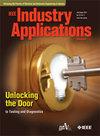Enhancing Resilient Operation of Distributed Energy Resources Using an Improved Machine Learning-Based IoT Framework Against Cyberattack Perturbation
IF 4.2
2区 工程技术
Q2 ENGINEERING, ELECTRICAL & ELECTRONIC
引用次数: 0
Abstract
The most realistic way to achieve large-scale integration of distributed energy resources (DERs) into the current grid system is to implement microgrids. These systems function as localized power grids that can operate independently or seamlessly integrate with utility grids. They include DERs, energy storage options, and a variety of loads. Microgrid architecture is changing toward greater distribution, intelligence, and close network integration as communication network technology develops quickly. Microgrids are useful in many fields, including Industry 4.0, smart cities, and the Internet of Things (IoT). However, the connection of the microgrid components and transfer of data via the internet network expose the data to cyber threats, including false data injection, side-channel noise intrusion (SNI), and adversarial attacks, which deteriorate the operation data analysis models such as machine learning (ML). This paper outlines the enhancement of resilient operation using reliable IoT based on reliable ML as a case study for online monitoring of smart inverters. Furthermore, a new ML algorithm is developed using an image processing procedure against cyberattack perturbation. Different levels of attack perturbation are executed using the fast gradient sign method (FGSM) and SNI to validate the robustness of the developed model.使用改进的基于机器学习的物联网框架增强分布式能源的弹性运行,以应对网络攻击扰动
实现分布式能源大规模集成到当前电网系统中最现实的途径是实施微电网。这些系统的功能就像本地化的电网,可以独立运行,也可以与公用事业电网无缝集成。它们包括DERs、能量存储选项和各种负载。随着通信网络技术的快速发展,微电网体系结构正朝着分布式、智能化、紧密网络集成的方向发展。微电网在许多领域都很有用,包括工业4.0、智慧城市和物联网(IoT)。然而,微电网组件的连接和通过互联网的数据传输使数据暴露于网络威胁之下,包括虚假数据注入、侧信道噪声入侵(SNI)和对抗性攻击,这些攻击会恶化操作数据分析模型,如机器学习(ML)。本文概述了使用基于可靠ML的可靠物联网增强弹性运行,作为智能逆变器在线监测的案例研究。此外,利用图像处理程序开发了一种新的机器学习算法,以对抗网络攻击扰动。采用快速梯度符号法(FGSM)和SNI进行了不同程度的攻击扰动,验证了所开发模型的鲁棒性。
本文章由计算机程序翻译,如有差异,请以英文原文为准。
求助全文
约1分钟内获得全文
求助全文
来源期刊

IEEE Transactions on Industry Applications
工程技术-工程:电子与电气
CiteScore
9.90
自引率
9.10%
发文量
747
审稿时长
3.3 months
期刊介绍:
The scope of the IEEE Transactions on Industry Applications includes all scope items of the IEEE Industry Applications Society, that is, the advancement of the theory and practice of electrical and electronic engineering in the development, design, manufacture, and application of electrical systems, apparatus, devices, and controls to the processes and equipment of industry and commerce; the promotion of safe, reliable, and economic installations; industry leadership in energy conservation and environmental, health, and safety issues; the creation of voluntary engineering standards and recommended practices; and the professional development of its membership.
 求助内容:
求助内容: 应助结果提醒方式:
应助结果提醒方式:


